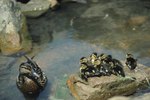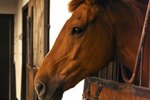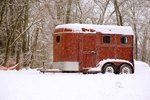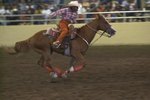
Mucking out a stall is the process of cleaning it by removing soiled bedding, old food, feces and urine. Horse stalls must be cleaned at least once a day when occupied by a horse. Stall cleaning is not a difficult task, but it does take time and physical effort to accomplish. The cleaner your stalls are, the healthier your horses will be.
Pitchfork
When cleaning a stall, it is normal to use a pitchfork to sift through the bedding. Plastic pitchforks are used commonly for removing feces and soiled bedding from inside a horse stall. The spread out tines of the pitchfork allow manure to be picked up out of the bedding without taking all the bedding along with it. Soiled bedding is kept on the fork and removed from the stall, while clean bedding can be shaken loose from the fork and kept in the stall. The pitchfork also can be used as a rake to spread out bedding and level it out within the stall.
Wheelbarrows and Muck Buckets
Wheelbarrows and muck buckets can be used to hold manure and soiled shavings as you clean the stall. When you use the pitchfork to remove soiled materials, you deposit them in either a wheelbarrow or a muck bucket. When the wheelbarrow or muck bucket is full, you can transport the them out to a compost or manure pile and dump the contents out.
Shovels
A flat shovel can be used to strip all the contents out of a stall. A shovel is more practical than a pitchfork if you need to take all the bedding out of a stall regardless of whether it is clean or dirty. It is normal to strip a stall every couple of months or when the stall becomes too dirty to salvage any of the bedding. Stalls also are stripped when a horse has been ill or a new horse is being moved into the stall.
Lime and Shavings
Calcium hydroxide, also known as lime powder, often is sprinkled in stalls to help neutralize the odor of ammonia. Lime typically is applied to the area of the stall where the horse has been urinating after the dirty shavings have been removed. The lime is sprinkled on the ground, and new wood shavings placed in the stall and spread out with your pitchfork. Your horse needs 8 inches to a foot of clean shavings in his stall. This provides a clean stall for your horse.
References
Photo Credits
-
Jupiterimages/Photos.com/Getty Images
Writer Bio
Jen Davis has been writing since 2004. She has served as a newspaper reporter and her freelance articles have appeared in magazines such as "Horses Incorporated," "The Paisley Pony" and "Alabama Living." Davis earned her Bachelor of Arts in communication with a concentration in journalism from Berry College in Rome, Ga.




